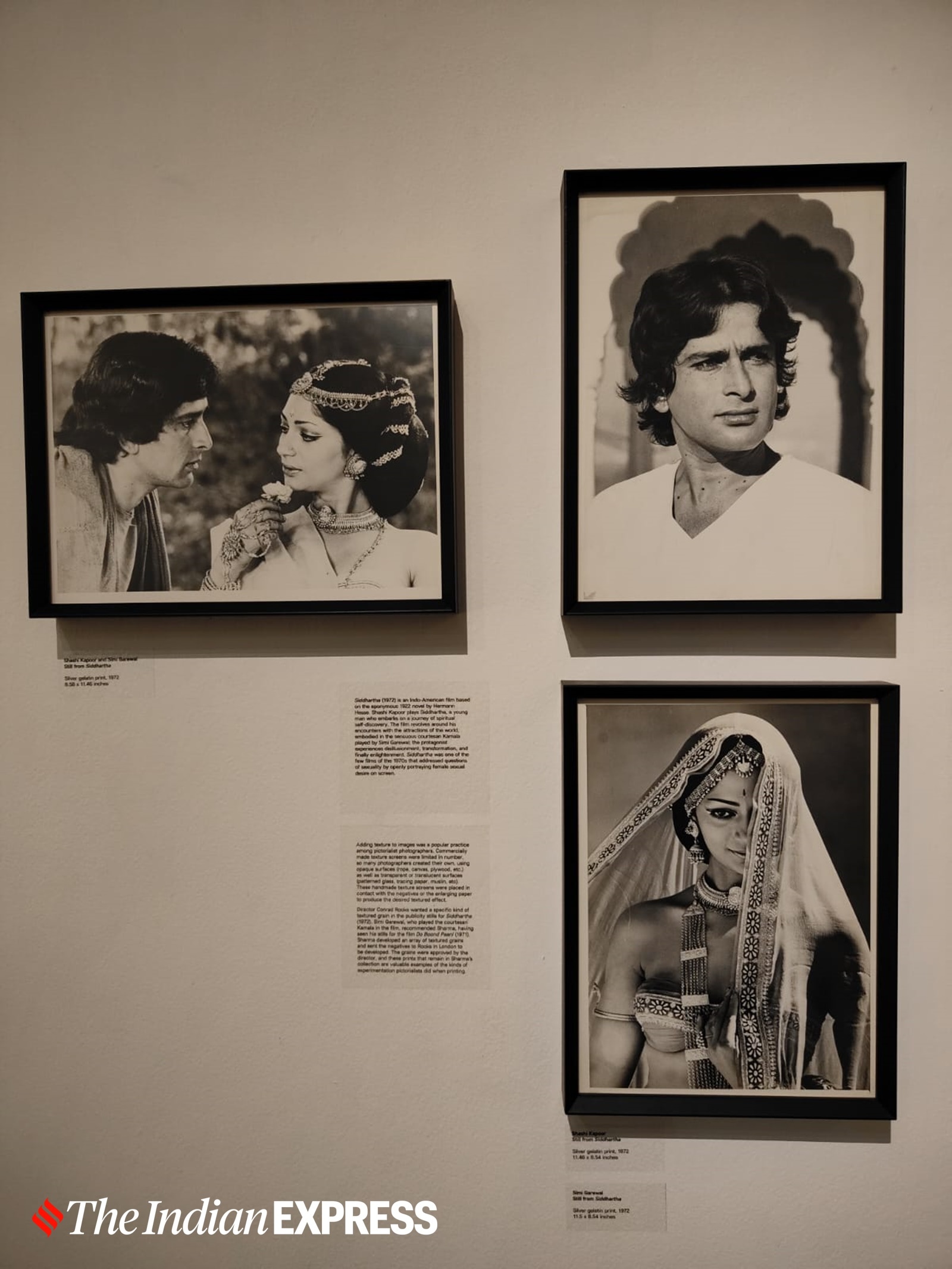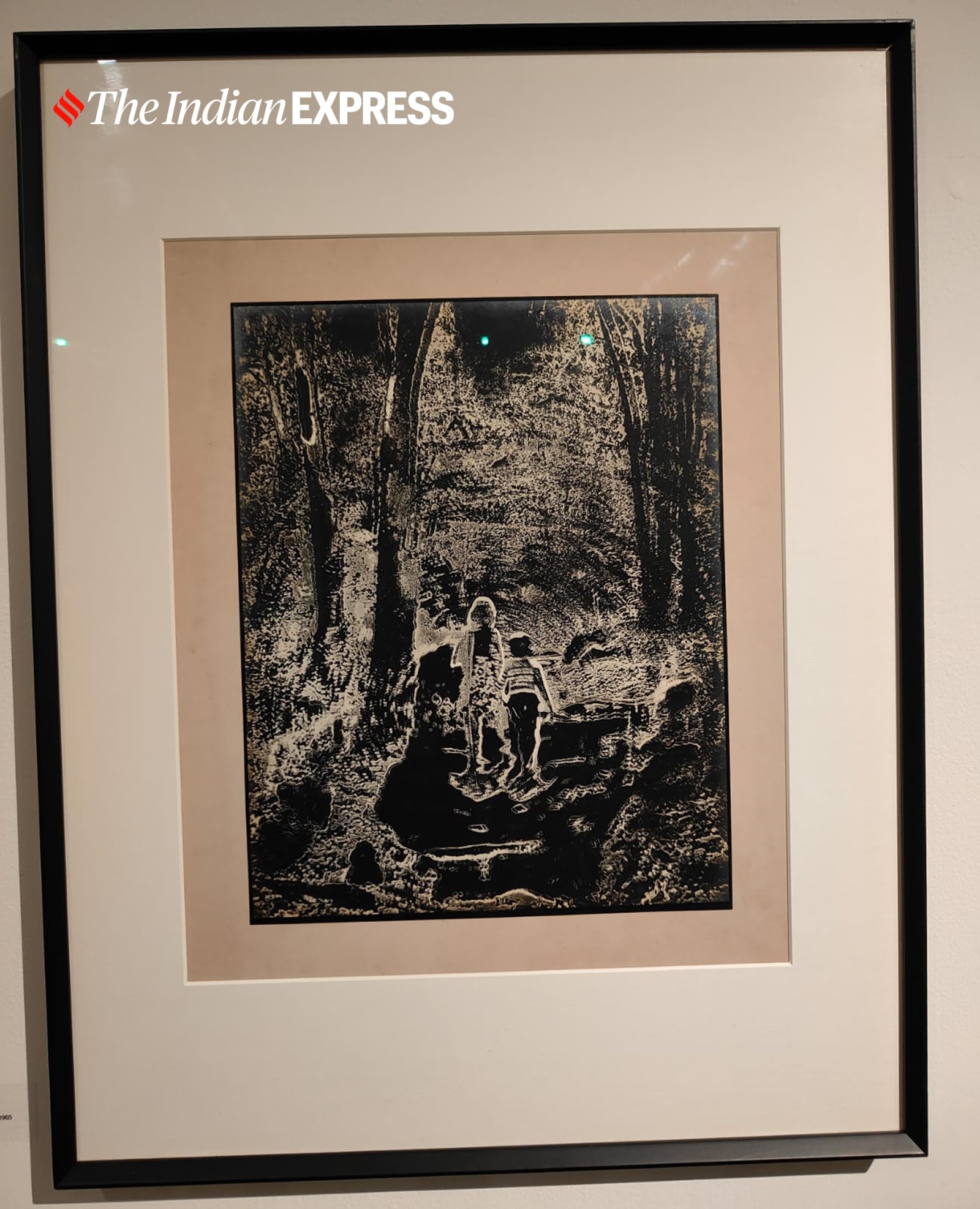
After moving to Delhi in the 50s, Sharma taught at Modern School, one of Delhi’s earliest post-Independence darkrooms. He was also affiliated with the U P Photographic Association, a self-organised group of “Pictorialist” photographers in Lucknow, engaged in discussions about aesthetics and practical darkroom techniques, sharing images and organising photography salons.
 OP Sharma worked on a series of photographs of Shashi Kapoor and Simi Garewal in the film Siddhartha (1972) (Photo credit: Ishika Roy)
OP Sharma worked on a series of photographs of Shashi Kapoor and Simi Garewal in the film Siddhartha (1972) (Photo credit: Ishika Roy)
“Standing at the cusp of a debate between analogue and documentary practice, he was unafraid to experiment with techniques. Sharma had also ditched the equipment to play around with light and chemicals to imprint photo-sensitive paper, producing photograms and photomontages, along with sodium sulphite prints and collages,” said Rahab Allana, curator of the Alkazi Foundation for the Arts.
Baskar highlighted Sharma’s love for experimenting in darkrooms, playing with a combination of negatives to compose an image. He introduced the concept of “making an image rather than taking one,” developing the C-effect—a detailed technique that produced unique textures through double solarisation. This technique involved rotating two negatives to create a swirl effect, which was then combined into a final negative and solarised again for printing.
“A connoisseur of music and poetry, Sharma was interested in calibrating tonal values. He was sensitive to the feelings of alienation and isolation borne due to urban culture taking people away from their roots. He believed in people artistically representing the sentiment of time,” said Baskar. “Through the craft of printmaking, I have to carve out my place in society,” she recounted the maestro’s wise words, who considered it a “meditative and solemn moment to make these prints while listening to Hindustani classical music”.
A peek into analogue photography techniques
For those new to analogue photography, photographer and sculptor Ashish Sahoo explained some foundational techniques.
Story continues below this ad
“A wet plate photograph, as the name implies, is taken on a wet plate. You have only about 15 minutes for the entire process, and the beauty lies in the uniqueness of each image. You must also consider exposure sensitivity, which ranges from 0.5 to 10 ISO.”
Sahoo said earlier methods used toxic chemicals, necessitating protective gear due to harmful fumes. “Today, non-toxic alternatives make the process safer,” he said.
Sahoo explained that silver gelatin prints are made on light-sensitive paper and require a darkroom for printing. Albumin prints, made with egg whites, arose from home experimentation. Contact prints were standard, and glass plates were eventually replaced by celluloid as technology advanced.
 “In the Wonder land” (1965) – Silver Gelatin Print, C-effect with solarisation (Photo credit: Ishika Roy)
“In the Wonder land” (1965) – Silver Gelatin Print, C-effect with solarisation (Photo credit: Ishika Roy)
While digital is forgiving, analogue requires considerable technical understanding and expertise. “To calculate the exposure and adjust it accordingly to the subject and its surroundings, one needs to be adept at math, physics and chemistry to take these prints,” Sahoo said. “You can’t see the end product till later when you go back to the darkroom and print it. There’s always this fear of screwing up the developing process, which ends in a re-shoot and money wasted,” he said. But that’s also what excites him about the process.
Story continues below this ad
Pointing to Sharma’s digital prints of a Bollywood veteran actor displayed on the walls, Sahoo shared how digital formats often lack the warm tones of darkroom prints. Ultimately, he believes the choice between digital and analogue lies with the individual photographer.
Sahoo expressed admiration for Sharma’s mastery of light, particularly the C-effect technique, which he considers “brilliant.” He is simply in awe of how Sharma used his photograms (prints made by physically placing objects on a piece of paper).
“The darkroom expertise and experimental spirit Sharma embodied opened many doors for me in my work. The vibrancy in his portraits has been vital to the liveliness I aim to capture in my photographs,” Sahoo said.



 OP Sharma worked on a series of photographs of Shashi Kapoor and Simi Garewal in the film Siddhartha (1972) (Photo credit: Ishika Roy)
OP Sharma worked on a series of photographs of Shashi Kapoor and Simi Garewal in the film Siddhartha (1972) (Photo credit: Ishika Roy) “In the Wonder land” (1965) – Silver Gelatin Print, C-effect with solarisation (Photo credit: Ishika Roy)
“In the Wonder land” (1965) – Silver Gelatin Print, C-effect with solarisation (Photo credit: Ishika Roy)
























